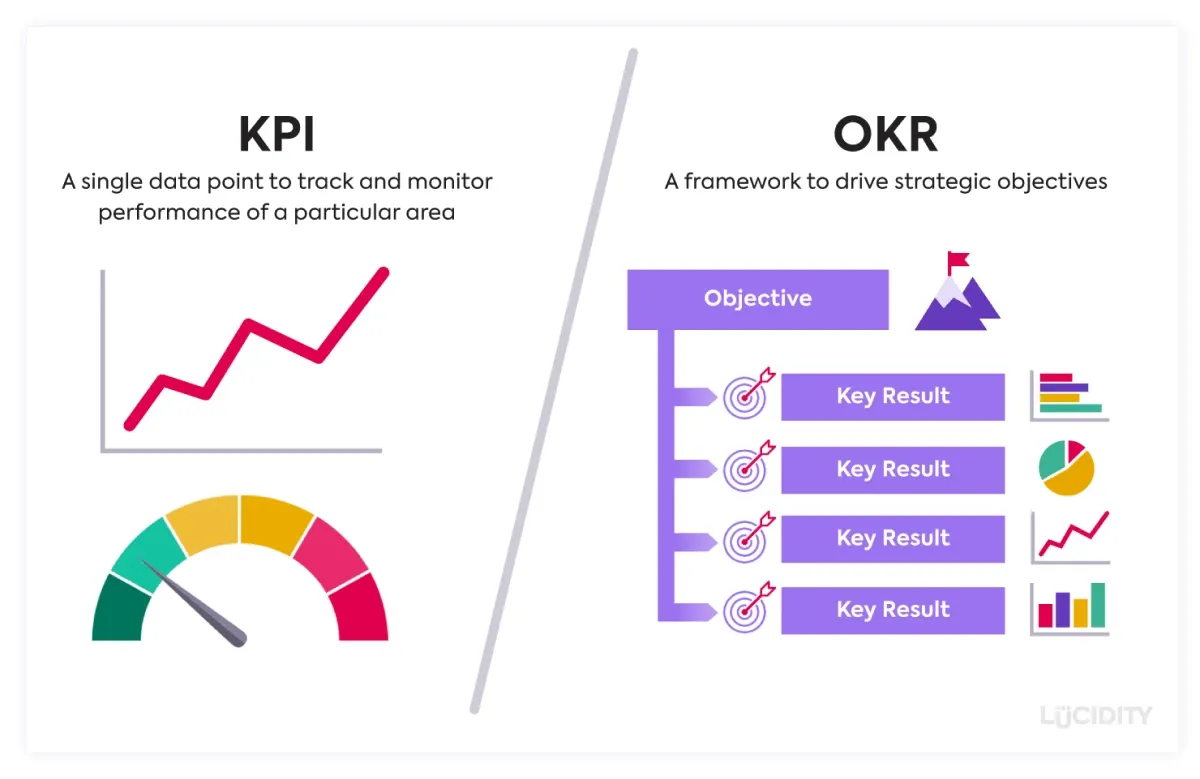Customer success OKRs that actually mean something

The bar for “good” customer success is rising, and the bar for “great” customer success is miles above it. Continuously striving to do better should be at the top of the list of priorities for customer success teams.
Merely checking off arbitrarily set KPIs may be good enough for temporarily appeasing the boardroom, but the cracks begin to show when you realize that what you’ve been measuring isn’t actually telling you anything about the success of your CS team.
Traditional reporting standards have been long overdue for an overhaul, and we think it’s about time CS teams shift from measurement to action.

OKRs vs. KPIs
When the topic of reporting comes up, two acronyms typically enter the conversation: KPIs and OKRs. So what’s the difference?
Key performance indicators (KPIs) are specific metrics that quantify certain outcomes. Their primary goal is measurement. Whereas objectives and key results (OKRs) are strategic frameworks that set ambitious objectives, as well as break down the steps needed to get there. The primary goal is planning and action.
KPIs are typically more static, tracking the ongoing performance of established processes, while OKRs are set periodically and focus on achieving specific goals that can evolve over time.
One of the easiest ways to think about how KPIs and OKRs vary is that one of the key results (the KR in OKR) could be a KPI.
For example, some teams may track a KPI of increasing email open rates by X%. A team using the OKR framework may have an objective of improving relationships with the customer, and underneath that objective, one key result could be increasing open rates by X%, alongside other metrics that help to measure customer relationships.
Traditional customer success KPIs
Often, customer success teams tend to focus on scattered KPIs, rather than theme-driven OKRs, as the main indicators of their success. In addition to the innate drawbacks of looking at your metrics in this disconnected way, they tend to place a lot of importance on vanity metrics.
Even though a lot of the most popular CS metrics are a good “temperature check” to see how they’re doing in certain areas, they have limited value in making real and specific decisions.
The problem is that they don’t get to the heart of the issue. They’re really great at identifying the symptoms, but not the cause.
I’ll show you what I mean.
Consider some of the most popular customer success metrics: NPS and customer satisfaction. It’s great to know what your customers are saying about you, but it introduces a few key limitations.
- First and foremost, they just tell you the extent to which users like or would recommend your product, not the why. Sure, many NPS or CSAT surveys have a section where people can elaborate on why they answered in the way they did, but many people choose to skip this.
- They are self-reported, meaning it’s highly influenced by their emotions in that moment and could vary greatly from their overall sentiment
- Since this insight is collected through survey responses, you’re likely to experience sampling bias. You’re also more likely to get the majority of responses from people who are having extreme feelings (positive or negative) about your product, which can skew your results.
There are a few other popular customer success metrics like conversion rate and customer churn rate that are undeniably valuable in measuring the actions that demonstrate continued investment in your product.
However, something that’s often missing from these metrics is one critical important ingredient: real engagement.
Engagement is your best indicator of customer health
What your users are saying and their tendency to renew their contracts are important, but they’re not granular enough. When you look at the metrics that trace real engagement happening in your product, you can identify trends that may not show up in your traditional metrics for several months down the road.
This helps you be more proactive about providing an incredible experience for your clients.
So now that you know all of the individual KPIs that should be on your list to track, let’s switch gears to talk about how to frame these within the OKR format to help your team stay laser-focused on specific overarching goals.
Meaningful customer success OKRs
OKR 1: Increase engagement in your product
Sales and marketing are most responsible for getting new customers in your platform, but much of the responsibility of getting them to stay in the platform rests on the customer success team’s shoulders. Generating more engagement in the product is one of the best ways to make sure you’re hitting this critical goal.
Whether you have a ton of new users in your platform that you’re trying to get ramped up, or you’re having ongoing issues with customers not using your platform as much as you should, this is a common customer success OKR for teams to aim for.
But like we said, you’ve got to get really specific and dive deeper than the popular vanity metrics. The key results that teams aim for can vary from team to team. In order to pursue the most meaningful key results, you have to decide what good engagement looks like to you.
Think hard about all of the possible actions that customers can take in your platform and decide which handful are most meaningful and likely to lead to long-term investment in the product.
Some key results that CS teams may set for this objective may revolve around:
- Increasing feature adoption - Maybe the number of new features adopted by users is the most relevant thing to track. For other products, the team may want to track the adoption of one key feature that they’re trying to boost.
- Increasing session duration - More time within your platform typically points to a more engaged user, so the customer success team may want to focus on strategies to keep people in the app longer.
- Increasing active users - Paying customers who go days, weeks, or months without hopping on your platform are only valuable for a certain amount of time. To make sure you’re building long-term customer relationships, your CS team may want to work on getting a larger portion of users to log on consistently.
- Increasing click-through rate - If your product has pop-ups that are meant to engage and educate your users, more clicks on them points to more engaged users since they’re demonstrating a desire to learn more.
[Graphic]
OKR 2: Increase satisfaction
This is what many teams are hoping to measure by sending out CSAT or NPS surveys. But by setting increasing satisfaction or retention as a key objective, they’re able to get more specific about how they’re going to do it. Not just sending out a survey again at the end of a time period and hoping they do better.
Not only does determining key results give you a more actionable plan to actually achieve your goal, but it also gives you a more accurate measure of if you truly do achieve your goal. Like we said earlier, self-reporting has its issues, engagement doesn’t lie.
When aiming to increase customer satisfaction some good key results could be:
- Boost retention rate - Unsatisfied customers aren’t likely to stick it out and keep paying over and over again. While this doesn’t mean they don’t have any problems (which is why no one metric should be considered by itself), it points to the fact that they’re getting something they need or want from the platform.
- Sentiment analysis - You can pull all of the interaction data, whether it’s from support messages, social media, or anywhere else to determine the overall sentiment towards your product. This is a more accurate reflection of how your users are feeling. Thanks to the explosion of conversational AI tools that can scale the number and depth of conversations that you have with your users, teams now have access to more data than ever.
- Boost feature usage rate - Satisfied customers are more likely to explore your platform and try out several different features, but it can also go the other way. Customers who have explored more of your platform are also more likely to understand the value it delivers. This doubled-edged benefit is a great way for CS teams to both strategize for how to increase satisfaction, as well as how to measure their success in doing so.
[Graphic]
OKR 3: Enhance the efficiency of customer support operations
Not all customer success OKRs may be customer-focused. Many CS teams may have an objective or two that revolve around improving their internal processes. Efficiency is typically one of the top goals for any team that is forward-looking.
When the team is able to use their time most efficiently and integrate processes or technology that help them do their jobs better or quicker, the benefits often trickle down to the customers, too.
Some key results that CS teams may pursue to increase internal efficiency are:
- Implementing conversational AI tools to scale agent support
- Reducing the average time to response on customer support tickets
- Increasing their knowledge resources
- Implementing automated user assistance tools to get proactive about supporting users
In-product insight should be at the heart of your customer success OKRs
To be clear, we’re not saying that you should abandon the legacy customer success metrics. We’re just saying you need to go deeper to truly understand the impact that your team is having on your users.
When you layer on real engagement metrics from users in your product, the picture becomes much clearer. Suddenly, color is added to all of the other metrics you’ve been pulling. The pain points become clear, but so do the areas where you’re really crushing it.
When you integrate engagement metrics into your customer success OKRs, you’ll be doing far more than just checking a box. You’ll be creating a blueprint for continuous improvement and success.
